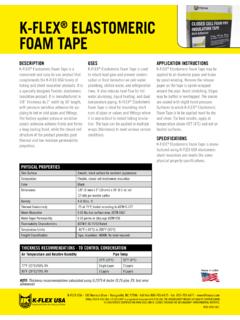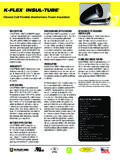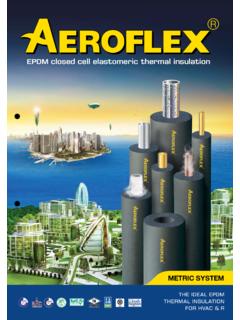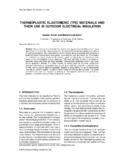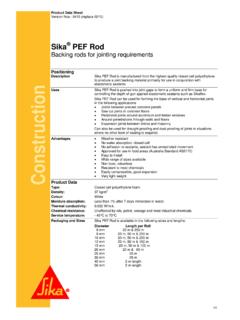Transcription of GRANOR ELASTOMERIC BEARINGS
1 COMPOUND CHARACTERISTICS SERIES BS bearing STRIP & PADS SpecificationResultHardness60 IRHD Duro +/- 5 Elongation475% Tensile MPa minElastic Modulus (E) Modulus (G) Modulus2000 Compression Set30% resistanceNo cracking after 100 hours at 20% strain, 40 C. and agingMax. permissible change in prop-erties; Hardness + 4, Tensile +/- 10%, Ultimate tensile strain - 15%QA Type 60 HDESIGN PARAMETERSThe design of ELASTOMERIC bearing Strip & bearing Pads is largely empirical. In the determination of the shape factor used in the computation process, a safety factor is incorpo-rated in order to ensure a reasonable correlation between the calculated compressive stiffness value and the actual test value.
2 This is largely an attempt to compensate for vari-ations of compressive stiffness as will be experienced in practice, due to the friction that will occur when different surfaces are in contact with the rubber. MATERIAL LENGTHSS tandard segment lengths are metre with some sizes also available in 2 metre lengths. By placement end to end on the headstock / corbel the support conditions become referred to as continuous .HOLESH oles can be provided. Alternatively, many contractors prefer to match mark and drill on moulded modules with countersunk or counter-bored holes are also available on special request. These are sometimes used as a means to hold vertically orientated buffer bearing pads in requiring holes in BEARINGS please clearly dimension these on the project 60 IRHD Duro +/- 5 Points Length +/- 5mmWidth +/- 3mm Thickness +/- 1mm Standard ThicknessesStandard thicknesses are 3, 6, 10, 13, 20, & 25mm.
3 Other thicknesses are available but by special order LIFEN atural rubber ELASTOMERIC BEARINGS have a reliable proven design life of at least 100 years with zero referred to as unreinforced bearing Pads or bearing Strip, they are pressure moulded from a high quality 60 IRHD hardness Natural Rubber compound to and NATA MRA Certification on Hardness, Tensile Strength, Compression Set and Ozone resistance is ELASTOMERIC BEARINGSPADS & STRIP, SERIES BSFRICTION CO-EFFICIENT VALUES RUBBER AGAINST INTERFACE (INDICATIVE) InterfaceCharacteristic friction co-efficient of rubber against nominated (indicative)Wood floated floated cast in situ against galvanized Part NumberCross Section (mm)Maximum Working load (kN/m) SLSM aximum Shear Deformation (mm)Compressive Stiffness (kN/mm per metre of strip)Shear Stiffness (kN/mm per metre of strip)Rotation (Rads.)
4 Maximum #BS-50-3/..*50 x ..*75 x ..*100 x ..*125 x ..*150 x ..*50 x ..*75 x ..*100 x ..*125 x ..*150 x ..*75 x ..*100 x ..*125 x ..*150 x ..*200 x ..*75 x ..*100 x ..*125 x ..*150 x ..*200 x ..*100 x ..*125 x ..*150 x ..*200 x ..*250 x ..*100 x ..*125 x ..*150 x ..*200 x ..*250 x ..*300 x for bearing pads and strips are derived from AS Design is based on Compressive Stiffness s are indicative only. Refer later notes.# This is the maximum rotation capacity when bearing strip is under maximum working load. * Total length of strip (or pad) required to be inserted in part number after the forward slash. Part No. Examples:BS-300-25/8000 = 8 metre long run of 300mm wide x 25mm thick ELASTOMERIC bearing strip segments placed end to = single ELASTOMERIC bearing pad 638mm long x 250mm wide x 20mm sizes outside of the table dimensions are also in most cases readily available, for example:BS-400-13/400 = single ELASTOMERIC bearing pad 400mm long x 400mm wide x 13mm ELASTOMERIC BEARINGS PADS & STRIP, SERIES BS / 3 ELASTOMERIC BEARINGS PADS & STRIP, SERIES BS GRANOR RUBBER & ENGINEERING8 REID STREET, BAYSWATER, VICTORIA 3153 AUSTRALIAEMAIL.
5 +61 3 9762 9699 VERTICAL LOADSL oads shown in table are the maximum recommended working / serviceabil-ity loads, at the maximum shear deformation shown. ELASTOMERIC BEARINGS are selected based on serviceability loads rather than ultimate design loads. ELASTOMERIC BEARINGS can tolerate significant overloading during ultimate limit state cases without harm hence this criteria does not STIFFNESSV alues shown in table are theoretical calculated values. They are considered as reasonable average values for the determination of rotational capacity. Actual values achieved in service will be influenced by the frictional charac-teristics of the contact surfaces against which the pad or strip is placed, eg. rough concrete, galvanised steel addition of a hole(s) into the pad or strips will cause a significant increase in compressive deflection at the rated load together with a corresponding de-crease in load capacity, ie.
6 The strip/pad will be softer, and thus, to keep within the design code for total strains, load carrying capacity is reduced. Consult with for detailed calculation methods. A factor of 25% reduction would be a reasonable assumption in many DEFORMATION / MOVEMENTS hear stiffness values shown are +/- from neutral position. It may be assumed that a strip / pad with dowel pin holes and thus not subject to shear deforma-tion, has a load carrying capacity in order of values shown in table for bearing strip / pad bearing of the load bearing surfaces relative to one another, is referred to as rotation . The criteria for rotational capacity is that the trailing edge of the pad does not go into tension, ie. No gap, but that it is always under a degree of compression.
7 Rotational capacity listed in the table is that applicable at rec-ommended maximum load. The relationship LOAD / ROTATIONAL CAPACITY is reasonably linear. Additionally, constructional errors of the seating and / or camber, hog etc., of beams should be considered in determining the required rotational capacity of the strip / with laminated ELASTOMERIC BEARINGS it is undesirable to have lift-off or loss of full contact due to rotational effects, with plain ELASTOMERIC BEARINGS a degree of lift-off , provided it is minimal, will not damage the reinforced strips / pads will spread when loaded. This is referred to as a squirming . The type of seating, steel, concrete, wood float / steel trowel finish rough / smooth, dry or wet, will all have an influence on the degree of squirming of the strip / pads under a compressive load.
8 Part recessing of the strip / pad or the use of an adhesive can reduce this problem, but not elimi-nate it. However, it is recommended that adhesives not be used as if they are used and fail, then the squirming and slippage could get worse. Slippage is the term used to describe the actual displacement of the strip / pad from its initial placement. This can occur at one or both faces. It is also referred to as walking out of the strip / pad. NOTE Where mechanical devices such as dowel studs are used to restrain the bearing , these devices may limit the depth of the elastomer available to accommodate shear deformation strips / pads will spread when loaded. Thus, the support area must be greater than the nominal plan size of the strip / pad.
9 We would recom-mend a minimum value of 25mm on all edges of the strips / pads, particularly if the structure is steel. If concrete, then the recommendation is 25mm all around. If a mortar pad is used, then minimum thickness is suggested as 10mm together with a 45 chamfer on the mortar pad sides. If the mortar pedestal is greater than 25mm, reinforcement may be necessary. Surfaces should be flat, free from cavities / projections, and preferably rough wood float finish in of adhesives is not OF ELASTOMER Temperature Effect - Within the range of -20 C to +80 C no significant vari-ation in performance will occur. Ozone - Ozone cracking in any elastomer will occur where there are surface tensile forces.
10 If cracking does occur, it is frequently harmless. It is simply re-lieving the surface tensions and further, deeper, cracking is unlikely. Longevity - Due partly to their small surface area to volume ratio, and in particular the small surface area exposed to the atmosphere during service, plus the location where such strips / pads are used, bearing strips / pads of high quality natural rubber will give an extremely long life - typically longer than the structure. Fire Resistance - Blocks of natural rubber do not burn easily. However, if fire resistance is considered essential, then in order to eliminate softening prob-lems, sheathing with a suitable fire retardant, or insulating material, foam etc, is suggested.


